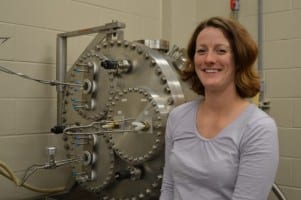Solving Static Electricity in Space
 There are many dangers when launching a vehicle into space from liftoff to landing, but one University of Central Florida researcher just secured a grant to help NASA solve a problem that doesn’t often catch headlines – electrostatic charging on spacecraft surfaces. The problem can lead to anything from fried electrical circuits to an explosion.
There are many dangers when launching a vehicle into space from liftoff to landing, but one University of Central Florida researcher just secured a grant to help NASA solve a problem that doesn’t often catch headlines – electrostatic charging on spacecraft surfaces. The problem can lead to anything from fried electrical circuits to an explosion.
Spacecraft in low-earth orbits are especially susceptible to space-radiation effects from Earth’s atmosphere. The hot and low-density plasma in the atmosphere can cause a charge to build up on the surfaces of a satellite or spaceship. When enough electrostatic charge has built up, it can discharge.
Adrienne Dove, a UCF physics postdoctoral research associate, is leading a team that will collect data from space to learn how the charging phenomena works, which may eventually lead to a way of solving the problem. Currently NASA must conduct a risk assessment of spacecraft using a worst-case scenario, which often causes costly redesigns or launch delays. Dove hopes her work will give NASA less expensive preventative options.
“Surface charging can take place beginning at launch and continue throughout a spacecraft’s orbit, and is a highly time- and location-dependent process,” Dove said. “Surface charging in atmospheric and space plasmas is a well-studied phenomenon, but because of the variability there is still much to learn.”
The grant work is for a small satellite, called SurfSat, to be launched by NASA under the CubeSat Launch Initiative. The three-year grant gives Dove and her team time to build the experiment at UCF’s Center for Microgravity Research in the Department of Physics, and then send it into low-Earth orbit to collect the data necessary.
Electrostatic discharges from differential charging of spacecraft materials has caused many spacecraft to fail prematurely and has caused permanent damage or upsets on more. The loss of the Atlas-Centaur AC-67 in 1987 is thought to be due to a transient electrical phenomenon. Electrical discharge problems can even happen on the launch pad, such as when lightning struck the Apollo 12 launch vehicle twice in 1969. Standards have been written to specify design and test requirements to mitigate differential charging that is known to cause upsets and damage on spacecraft, but sometimes there are design limitations depending on the space vehicle. Because so many factors can contribute to surface charging and cause a discharge, there is room to come up with some prevention methods as opposed to having to try and resolve the problem after spacecraft have been built.
Dove explained in her grant proposal that to assess the risk to the spacecraft or launch vehicle these surface materials pose, a worst-case model must be used. Because the energy released in a dielectric electrostatic discharge is material dependent, the standard models may be overly conservative and can result in unnecessary design changes or costly mission delays.
The mission’s goal is simple: it aims to explore the range of conditions that create discharge events from these materials using an experiment that will float on a CubeSat in low-Earth orbit.
“The team’s approach will allow us to characterize the spacecraft environment and understand the rate and magnitude of discharges from dielectric surfaces,” she said.
SurfSat also has a secondary objective – a greater understanding of the discharge conditions for surfaces will lead to the refinement of design criteria for launch vehicles in order to help avoid potentially disastrous discharging on spacecraft.
Other members of Dove’s team include: UCF professor Joshua Colwell, Kennedy Space Center aerospace engineers Dawn Trout and Janessa L. Buhler (who is also a UCF Physics graduate student), University of Arkansas associate professor of mechanical engineering Larry Roe, and UCF research assistant Doug Maukonen.
Dove joined UCF in 2012. Previously she had been a research assistant at the Laboratory for Atmospheric and Space Physics at the University of Colorado at Boulder. She did her undergraduate work at the University of Missouri, and holds several degrees including a Ph.D. from the University of Colorado at Boulder in astrophysical and planetary sciences. She also serves as a reviewer for several journals and has presented at various conferences.
To view the original article please visit UCF Today.
